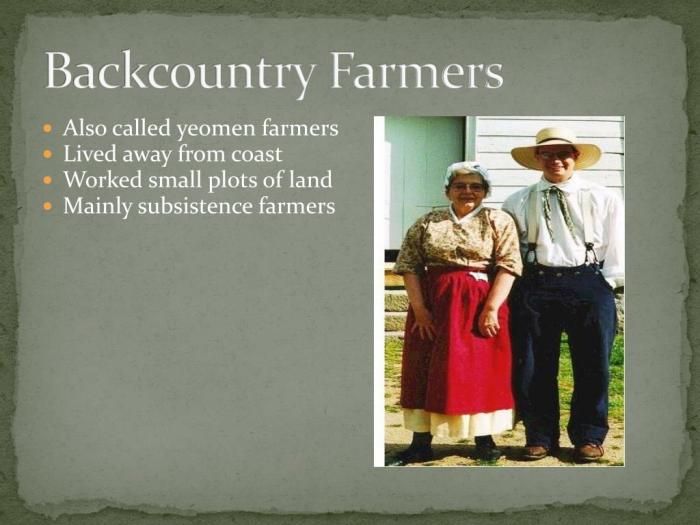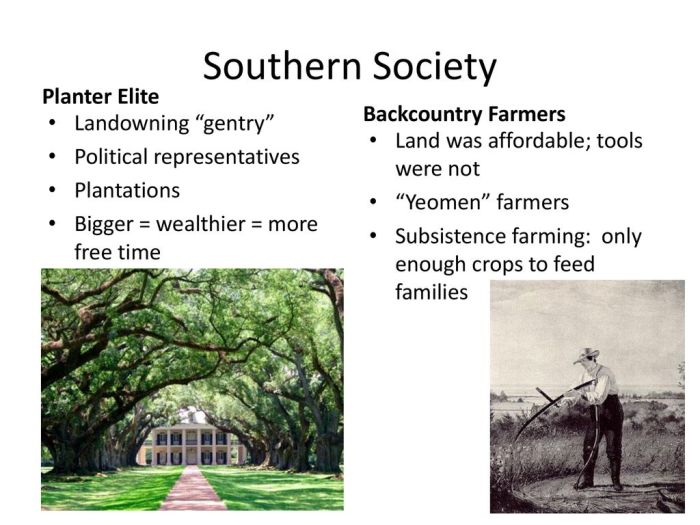Southern farmers in the backcountry inhabited a rugged and unforgiving landscape, their lives shaped by a complex interplay of economic, social, and environmental factors. This essay delves into the intricate fabric of their existence, shedding light on their struggles, resilience, and the unique cultural traditions that emerged from their isolated communities.
From the challenges of subsistence farming to the complexities of social hierarchy, the backcountry farmers faced a myriad of obstacles. Yet, they persevered, developing innovative economic strategies and forging strong bonds of kinship and community. Their experiences offer valuable insights into the complexities of rural life in the early United States.
Economic Factors

The cash crop system had a profound impact on the lives of southern farmers in the backcountry. The cultivation of cash crops, such as tobacco, cotton, and rice, became the primary source of income for many farmers, leading to a shift away from subsistence farming.
This shift had both positive and negative consequences. On the one hand, cash crops provided farmers with a source of income that could be used to purchase goods and services that were not available in the backcountry. On the other hand, the cash crop system also led to increased debt and dependency on merchants and landowners.
Challenges Faced by Subsistence Farmers
Subsistence farmers in the backcountry faced a number of challenges. The soil was often poor, and the climate was unpredictable. Farmers also had to contend with pests and diseases. As a result, many subsistence farmers lived in poverty.
Economic Strategies Employed by Southern Farmers
Southern farmers in the backcountry employed a variety of economic strategies to survive. Some farmers diversified their crops, planting a variety of crops to reduce the risk of crop failure. Others raised livestock, such as pigs and chickens, to supplement their income.
Some farmers also worked as laborers for wealthier farmers or landowners. Others turned to hunting and fishing to provide food for their families.
Social Structure

The social hierarchy in the backcountry was based on land ownership. The largest landowners were at the top of the social hierarchy, followed by small landowners, tenant farmers, and sharecroppers.
Kinship and family ties were also important in backcountry society. Extended families often lived together, and families provided support for each other in times of need.
Social Customs and Traditions, Southern farmers in the backcountry
Southern farmers in the backcountry practiced a variety of social customs and traditions. These customs and traditions included:
- Barn raisings, where neighbors came together to help build a barn for a new family
- Quilting bees, where women gathered to make quilts for the needy
- Corn shuckings, where neighbors gathered to shuck corn for the winter
Political and Legal Context

The political and legal framework that governed the lives of southern farmers in the backcountry was based on English common law. The colonial authorities appointed justices of the peace to maintain order in the backcountry. Justices of the peace were responsible for settling disputes, collecting taxes, and enforcing the law.
The relationship between the backcountry farmers and the colonial authorities was often strained. Farmers resented the taxes and regulations imposed by the colonial government. They also felt that the colonial government did not provide them with adequate protection from Native American attacks.
Legal Disputes and Conflicts
A number of legal disputes and conflicts arose in the backcountry. These disputes often involved land ownership, debt, and criminal offenses. Some of the most common legal disputes included:
- Boundary disputes, where farmers argued over the ownership of land
- Debt disputes, where farmers borrowed money from merchants and landowners and then failed to repay their debts
- Criminal offenses, such as theft, assault, and murder
FAQ Overview: Southern Farmers In The Backcountry
What were the primary economic activities of southern farmers in the backcountry?
Subsistence farming and cash crop cultivation, primarily tobacco, cotton, and indigo.
How did the social hierarchy in backcountry communities differ from that of urban areas?
It was less rigid, with a greater emphasis on kinship and personal relationships.
What role did religion play in the lives of backcountry farmers?
It provided spiritual comfort, fostered a sense of community, and influenced social customs and traditions.